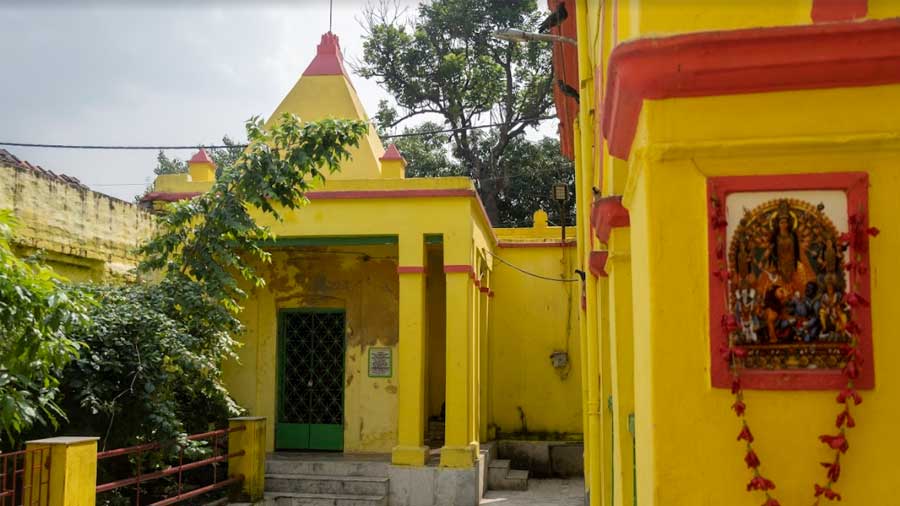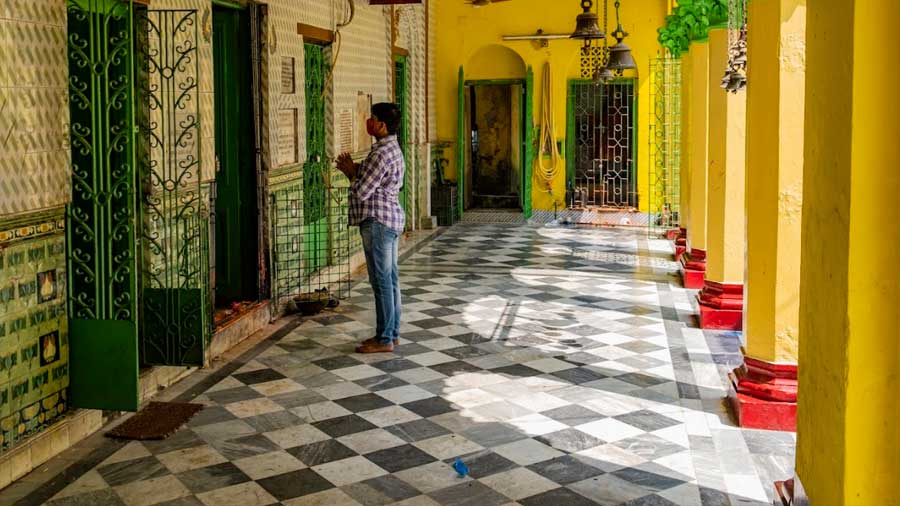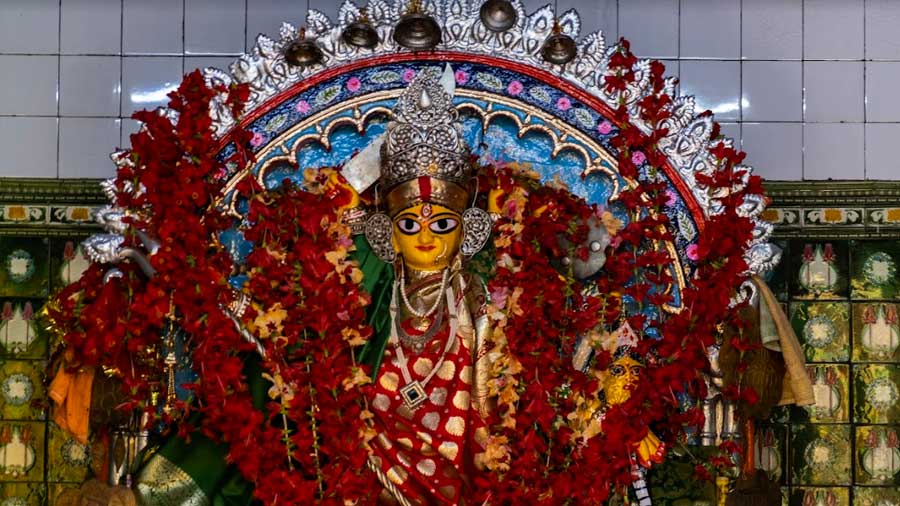Chitte, one of the fiercest dacoits in sixteenth-century India, once had a dream that changed his life, or at least his legacy. In his dream, he was instructed by Ma Durga to collect a giant block of wood that would be floating in from the Ganges, and build an idol of the goddess out of that block.
And Chitte did just that, creating what is now regarded as the oldest idol of Durga in Kolkata, worshipped at the Adi Chitteswari Durga temple.
“Chitte would rob from rich zamindars and chieftains and distribute the wealth to the poor. Praying to Durga and continuing a life of relentless robbery went in tandem for him,” explains Kashiswar Roy Chowdhuri, the man currently responsible for supervising proceedings at the Chitteswari temple.

Yellow and red impart a distinct vibrancy to the premises of the temple Courtesy of Adi Chitteshwari Durga Temple
Established in 1610, the temple is located on Khagendra Chatterjee Road in Kolkata’s Cossipore, right opposite the Cossipore Gun and Shell Factory. Painted in a vibrant combination of yellow and red, one of the temple’s claims to fame has been its age, which is frequently touted to be greater than that of Kolkata itself.
If we consider the birth date of Kolkata as August 24, 1686 — the day an official from the British East India Company called Job Charnock first set foot on these shores — then the Chitteswari temple stands older. But the Calcutta High Court has already discredited Charnock as the founder of Kolkata, meaning the exact age of the city remains elusive.
Centred around a spacious natmandir that faces the sublime figure of Durga, the understated architecture of the temple houses several other members of the Hindu pantheon. Flanking Durga on either side are Shiva and Hanuman while diagonally to Durga’s left is another avatar of Shakti — in the form of Ma Shitala. A quaint corner of the temple makes space for the trio of Jagannath, Balaram and Subhadra, alongside the eternally tranquil Lokenath Baba. At the far end, close to the exit, is a small room for Radha and Krishna.

The neem tree found in the shashan behind the temple that has stood aloft for centuries Courtesy of Adi Chitteshwari Durga Temple
The back of the temple contains a rarely used shashan, once frequented by tantriks and the heads of owls, dogs, monkeys, snakes and frogs. A sizable neem tree, believed to have existed for centuries, still stands strong adjoining the shashan.
The Durga idol, which is the focus of attention for devotees is the same idol that Chitte had built, exudes a sense of stillness. With her 10 hands, but without her retinue of Ganesh, Karthik, Lakshmi and Saraswati, Chitteswari does not invoke the same aura as the Durga idols spotted at glamorous pandals during this time of the year. Instead, her strength and charm are subtle, the kind that grows on the onlooker.
At the feet of Chitteswari is a white lion biting the hand of Mahishasur, with a short but intense tiger lurking in the vicinity.

The idol of Shitala draws the second most devotees in the temple after the main idol of Durga Courtesy of Adi Chitteshwari Durga Temple
“The tiger is a reminder of the fact that this area used to be covered entirely by forests at one point and wading through these parts at night could have been a matter of life and death,” describes Chowdhuri.
During Chitte’s time, Chitteswari was an outlying goddess, as dacoits, generally supplicants of Kali, did not worship Durga. Offering of human flesh as sacrifice to placate Durga was also unprecedented, but it happened for Chitteswari, confirms Chowdhuri.
After Chitte passed away, Chitteswari went missing for years, until a sadhu by the name of Nrisingha Brahmachari managed to unearth her following another nocturnal intervention by the goddess. Brahmachari built a tiny shelter for the idol, but was soon approached by the local zamindar who wanted to construct a temple fit for the adoration that Chitteswari deserved.

A devotee offers his prayers to Chitteswari in the midst of perfect tranquility Courtesy of Adi Chitteshwari Durga Temple
This zamindar, claimed to be Gobindaram Mitra by some and Manohar Bose by others, handed over a large new temple to Brahmachari in 1610, which is where Chitteswari has remained since.
Brahmachari and his disciples kept the temple functioning for decades, before the baton was passed to the Roy Chowdhuri family, now represented by Kashiswar.

Radha and Krishna can be found nestled in a corner, just ahead of the temple’s main gate Courtesy of Adi Chitteshwari Durga Temple
“My father has been coming here for years. Seeing him, I, too, have become a devotee of Chitteswari and now my son is here as well,” says Amit Kumar Shaw, 41, with his son Shivansh, all of two-and-a-half years, strutting around the premises.
During Durga Puja, Chitteswari is feted and festooned as an annual fervour grips the temple. At other times, the Durga that is never submerged, provides for an oasis of peace — a place where one can sit, think and pray in silence, temporarily suspending the chaos of life.
Video and images: Ritagnik Bhattacharya
